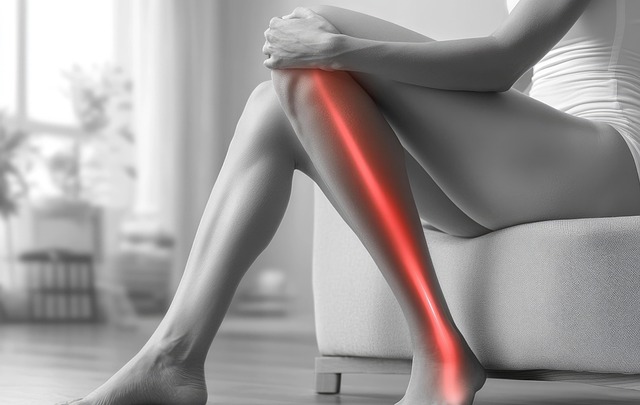Platelet-rich plasma (PRP) therapy uses a patient's own blood to accelerate tissue repair for muscle injuries like tendinitis and strains. PRP is injected into affected areas to stimulate collagen production and cellular responses, offering a natural alternative to anti-inflammatory drugs and surgeries with minimal downtime. Effective in treating tendon conditions, PRP leverages the body's healing power to provide fast pain relief and improved function, making it a game-changer in sports medicine for managing muscle injuries.
“Discover the revolutionary potential of Platelet-Rich Plasma (PRP) as a cutting-edge therapy for tendon injuries, including tendinitis and strains. This natural, powerful treatment option is gaining traction in sports medicine due to its effectiveness in accelerating healing and reducing inflammation. Understanding PRP’s mechanism, from its ability to stimulate tissue regeneration to its benefits over traditional methods, could be the key to faster recovery from muscle injuries. Explore the step-by-step process and recovery timeline of PRP treatments.”
Understanding Platelet-Rich Plasma (PRP) Therapy
Platelet-Rich Plasma (PRP) therapy is an advanced, natural healing technique gaining popularity in sports medicine and rehabilitation. This treatment involves extracting a patient’s own blood and separating it to concentrate platelets, which are rich in growth factors and play a crucial role in tissue repair. PRP for muscle injuries has shown promising results in accelerating the healing process of tendinitis and strains.
During a PRP therapy session, the concentrated platelet-rich plasma is injected into the affected area, delivering a surge of bioactive proteins that stimulate cellular responses to promote collagen production and tissue regeneration. Unlike traditional anti-inflammatory medications, PRP offers a more natural approach by harnessing the body’s inherent healing mechanisms, making it an attractive option for athletes and individuals seeking an effective solution for persistent tendon injuries without invasive surgeries.
How PRP Works for Tendon Injuries
Platelet-rich plasma (PRP) is a cutting-edge treatment option that has gained significant attention in sports medicine and rehabilitation. When applied to tendon injuries, PRP works by harnessing the body’s natural healing process. It involves extracting blood from the patient, spinning it down in a centrifuge to isolate the platelets, which are rich in growth factors and proteins essential for tissue repair. These concentrated platelets are then injected into the affected tendon area, promoting a cascade of events that accelerate healing.
PRP stimulates angiogenesis, encouraging the formation of new blood vessels, enhancing oxygen and nutrient delivery to the injured tendon. The growth factors released by platelets also attract stem cells, which play a crucial role in regenerating damaged tendon tissue. This natural approach has shown promising results in treating tendinitis, strains, and other tendon-related conditions, offering patients an alternative to surgical interventions with minimal downtime and reduced risk of complications.
Benefits of PRP for Tendinitis and Strains
Platelet-rich plasma (PRP) therapy offers a promising and effective approach to treating tendinitis and muscle strains. By harnessing the body’s own healing mechanism, PRP accelerates the natural repair process. It contains a high concentration of platelets, which are rich in growth factors that promote tissue regeneration and reduce inflammation. This non-invasive treatment has gained popularity among sports medicine professionals due to its ability to provide rapid relief from pain and improve overall tendon health.
One of the key advantages of PRP for these injuries is its ability to stimulate collagen production, fostering a stronger and healthier tendon environment. The growth factors released by platelets encourage cellular proliferation, enhancing tissue repair and flexibility. Additionally, PRP can reduce the inflammation associated with tendinitis and strains, providing patients with faster recovery times and improved function. This innovative therapy has shown promising results, making it a game-changer in the world of muscle injury treatment.
The Process and Recovery of PRP Treatment
The process of Platelet-Rich Plasma (PRP) treatment for tendon injuries involves multiple steps. Initially, a small amount of the patient’s blood is drawn and placed in a centrifuge machine. This machine spins the blood at high speeds to separate its components, concentrating platelets from other blood cells. Platelets are rich in growth factors, which have been shown to promote healing. The concentrated PRP is then carefully injected into the affected tendon area.
Recovery after PRP treatment typically begins with some mild discomfort and swelling at the injection site. Patients may be advised to rest and apply ice for a few days to manage these symptoms. Over time, as the growth factors are released, the body’s natural healing process is accelerated. This can lead to reduced pain, improved tendon strength, and faster recovery from tendinitis or muscle strains. The effects of PRP treatment can vary depending on the severity of the injury and individual responses, but many patients experience significant improvements in their range of motion and overall function.
Platelet-rich plasma (PRP) therapy has emerged as a promising treatment option for tendon injuries, offering significant benefits in managing tendinitis and strains. By utilizing the body’s natural healing mechanism, PRP accelerates tissue regeneration and reduces inflammation. This non-invasive approach is an effective alternative to surgery, providing relief and faster recovery for individuals suffering from muscle injuries. With its successful track record and minimal side effects, PRP therapy is a game-changer in sports medicine and orthopaedics.
